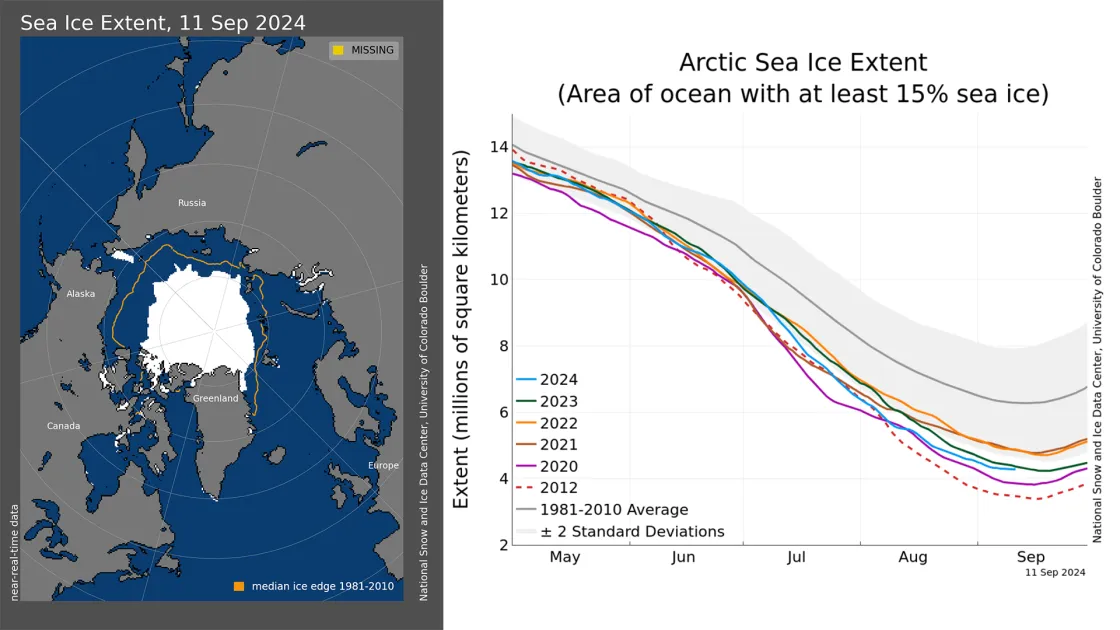On September 11, Arctic sea ice likely reached its annual minimum extent of 4.28 million square kilometers (1.65 million square miles). The 2024 minimum is the seventh lowest in the nearly 46-year satellite record. The last 18 years, from 2007 to 2024, are the lowest 18 sea ice extents in the satellite record.
In the Antarctic, sea ice extent tracked at its second lowest level in the satellite record for most of the growth season. Fluctuations in extent are typical of Antarctic sea ice extent near the seasonal maximum, but a record low maximum is unlikely. The maximum for Antarctic sea ice typically occurs in late September or early October, but has been reached as early as August 30.
Note that this is a preliminary announcement. Changing winds or late-season melt could still reduce the Arctic ice extent, as happened in 2005 and 2010. NSIDC scientists will release a full analysis of the Arctic melt season, and discuss the Antarctic winter sea ice growth, in early October.
Overview of conditions
On September 11, Arctic sea ice reached its annual minimum extent of 4.28 million square kilometers (1.65 million square miles) (Figure 1a). As autumn begins and the sun dips below the Arctic horizon, falling air temperatures will promote the expansion of ice extent throughout the growth season. However, with significant patches of low ice concentration currently remaining, a late-season storm could still compress the sea ice and push the ice extent even lower.
If September 11 holds as the minimum date, the 2024 minimum extent was reached three days earlier than the 1981 to 2010 median minimum date of September 14. The interquartile range of minimum dates is September 11 to September 19.
Note that a gap exists in the input source data between September 12 and September 18. This gap somewhat lowers our confidence in the minimum extent estimate. However, it appears that September 11 is the mostly likely date of the minimum based on data trends in daily extent values leading up to the 5-day average on September 11 and the extent values after data restarted on September 18. If extent did drop further between September 11 and September 18, it would have been marginal. If the input source data becomes available to fill that gap, our team will update the minimum estimate if necessary.
Conditions in context
This year’s minimum extent, based on a 5-day average, appears to have been set on September 11. It is 890,000 square kilometers (344,000 square miles) above the satellite-era record minimum extent of 3.39 million square kilometers (1.31 million square miles), which occurred on September 17, 2012 (Figure 1b). It is also 1.94 million square kilometers (749,000 square miles) below the 1981 to 2010 average minimum extent, which is equivalent to nearly three times the size of Texas.
In the 46-year-satellite record, the 18 lowest minimums have all occurred in the last 18 years.
The overall, downward trend in the minimum extent from 1979 to 2024 is 12.4 percent per decade relative to the 1981 to 2010 average. From the linear trend, the loss of sea ice is about 77,000 square kilometers (30,000 square miles) per year, equivalent to losing the state of South Dakota or the country of Austria annually.
| RANK | YEAR | MINIMUM ICE EXTENT | DATE | |
|---|---|---|---|---|
| IN MILLIONS OF SQUARE KILOMETERS | IN MILLIONS OF SQUARE MILES | |||
| 1 | 2012 | 3.39 | 1.31 | Sept. 17 |
| 2 | 2020 | 3.82 | 1.47 | Sept. 16 |
| 3 | 2007 2016 2019 | 4.16 4.17 4.19 | 1.61 1.61 1.62 | Sept. 18 Sept. 10 Sept. 18 |
| 6 | 2023 | 4.23 | 1.63 | Sept. 19 |
| 7 | 2024 | 4.28 | 1.65 | Sept. 11 |
| 8 | 2011 | 4.34 | 1.68 | Sept. 11 |
| 9 | 2015 | 4.43 | 1.71 | Sept. 9 |
| 10 | 2008 2010 | 4.59 4.62 | 1.77 1.78 | Sept. 19 Sept. 21 |
Values within 40,000 square kilometers (15,000 square miles) are considered tied.
For more information
NASA visualization of 2024 Arctic sea ice minimum extent
